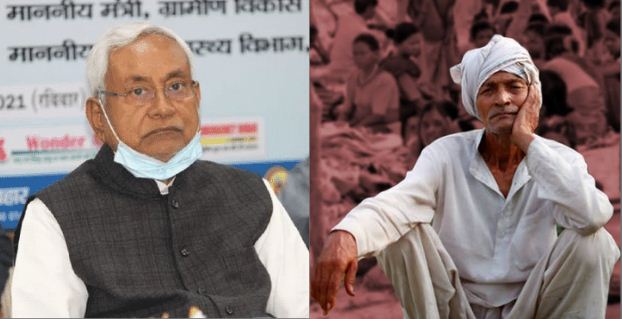24 years ago, Rashtriya Janata Dal (RJD) was founded and it spelled doom for Bihar and its fortunes in the subsequent years. The soiled legacy was only carried forward by the emergence of Nitish Kumar. The ‘Susashan Babu’, who has completed 15 years in the state as a Chief Minister, along with Lalu Prasad Yadav are responsible for pushing the development locomotive of Bihar six decades back in their three decades of misrule.
In the absence of a strong face in the BJP camp and through some scheming from the JDU, Kumar managed to get his hands on the CM chair once again last year. However, Bihar is in a desperate need of a Chief Minister that is driven by an ambition to steer the raggedy state towards the path of progress. A Chief Minister who can bring business and industries to the state is the urgent need of the hour.
According to statistics shared by Rao Inderjit Singh, Minister of State (Independent Charge) of Ministry of Statistics & Programme in the parliament, a high proportion (33.74 per cent) of the population in Bihar lives below the poverty line, and as high as 52.5 per cent suffers from multidimensional poverty. Only 12.3 per cent of households have any usual member covered by health insurance. As many as 42 per cent of children under five years are stunted, which is the highest in the country. It has the lowest literacy (64.7 per cent) in the age group of 15 years and above.
Investment proposals in Bihar haven’t been awe-inspiring- the Industrial Investment Promotion Policy (IIPP), which was launched by the state in the year 2016 and up until 2019 had received proposals of only Rs 14,855 crore.
However, props should be given to the optimism of Nitish Kumar who has found a silver lining in such a precarious situation as well.
“It is true that big industries didn’t come to the state despite our serious effort. Most of the industries prefer a state where there is port and sea. We are a landlocked state,” Kumar had said last year, before adding, “Despite no industry coming Bihar regularly grew by more than 10 per cent every year.”
Reported by TFI, MGNREGA workers in Bihar get only 30 to 35 days of work on an average in the state instead of 100 days. As per official data, the average number of days of employment that MGNREGA provided for those in the state, including those who worked even for a day, was 41.94 days in 2019-20.
During the financial year 2018-19, the average number of days of employment provided was 42.19. The number in question was 36.36 days in 2017-18 and 37.37 days in 2016-17. About 24,573 out of 29.24 lakh households got 100 days of work during 2018-19, 15,556 out of 22,47 lakh in 2017-18, and the corresponding figure for 2016-17 was 14,165 of 22.86 lakh households, according to Newsclick.
A quick comparison might help one understand how inept Nitish Kumar has been in the entire fiasco. Uttar Pradesh under CM Yogi Adityanath has been on an overdrive to bring big industries to his state. A German shoe manufacturing company had earlier announced that it will set its camp in the Hindi-heartland.
Yogi has done away with the labour laws for three years and has hosted dozens of blue-chip companies, corresponding with them and shown his willingness to accommodate them all. Meanwhile, Nitish Kumar after announcing Bihar a ‘dry state’ has failed to curb the ‘Liquor Mafia’ problem. Thus, it makes sense that rather than fighting a lost battle, Nitish should ease the licencing process to ensure that the issue of bootlegging does not severely affect the state.
When it comes to investment, over the last four years, the textile companies have invested 8,700 crore rupees in Uttar Pradesh with Kanpur, Noida, and Gorakhpur emerging as major investment destinations. A total of 66 new factories are to be opened in the state, of which 12 are already operational, employing more than 3,000 people, 18 are expected to start production next year, and another 18 are under construction.
Bihar, on the other hand, has been left gawking. The recent exit of Kitex, the world’s second-largest manufacturer of kids garments from the southern state of Kerala was a once-in-a-lifetime opportunity for the Nitish Kumar government to quickly chalk out a proposal and invite the company to the state.
However, much like last year when Nitish did not even bother contacting companies that were leaving China and coming to India, the state did not make a single effort to woo the company.
In other areas too, Uttar Pradesh is performing far better than Bihar. For example, while both the states have traditionally faced agrarian distress despite having the most fertile soils to boost the private sector because they were not able to make full use of the green revolution unlike Haryana and Punjab, Yogi government in Uttar Pradesh has inched ahead of the Nitish government in Bihar when it comes to delivering rural welfare schemes.
While wokes might have a heartburn at the statement but Bihar desperately needs a staunch capitalist Chief Minister. The menace of socialism aka Samajwad has driven the state into the ground. And if the state cannot find such leader, the fate of citizens of Bihar will be like that of a hamster running in a wheel, continuously working hard but never achieving anything and eventually drifting into nothingness.


































